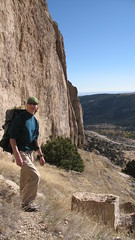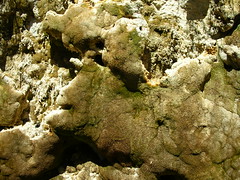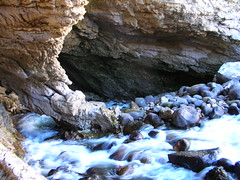 The day begins with only a stiff wind. We optimistically don our climbing packs and start toward the cliff walls of the Fairfield Hill area of Sinks Canyon. Those cliffs are more distant than they look – we hike for an hour just to reach them. By that time it’s very windy. We tour the base of the cliffs, finding one route (L.L. and L. 5.8) sheltered enough to climb in the high wind. That wind just continues to pick up, and we resign ourselves to a tour of the caves and roofs that make Sinks unique.
The day begins with only a stiff wind. We optimistically don our climbing packs and start toward the cliff walls of the Fairfield Hill area of Sinks Canyon. Those cliffs are more distant than they look – we hike for an hour just to reach them. By that time it’s very windy. We tour the base of the cliffs, finding one route (L.L. and L. 5.8) sheltered enough to climb in the high wind. That wind just continues to pick up, and we resign ourselves to a tour of the caves and roofs that make Sinks unique.  The most unique sight to us may have been a spongy green moss growing at the base of one wall that seemed to be conducting white minerals to the surface where they began to harden. Very strange stuff.
The most unique sight to us may have been a spongy green moss growing at the base of one wall that seemed to be conducting white minerals to the surface where they began to harden. Very strange stuff.
 Ann’s parents pick us up after lunch and take us to the main attraction and namesake of the canyon, The Sinks. I had read that the Popo Agie disappears underground for a quarter mile, but I didn’t imagine it just pouring into a giant cave. You can walk down into it a little ways, and at this time of year there are dry places where water goes under in higher runoff. The cave just gets shorter and shorter until it gets plugged up with sticks.
Ann’s parents pick us up after lunch and take us to the main attraction and namesake of the canyon, The Sinks. I had read that the Popo Agie disappears underground for a quarter mile, but I didn’t imagine it just pouring into a giant cave. You can walk down into it a little ways, and at this time of year there are dry places where water goes under in higher runoff. The cave just gets shorter and shorter until it gets plugged up with sticks.
 No one knows what route the river takes underground before it rises again. Studies using dyes have shown that it takes the water longer than expected to reach The Rise, and that more water Rises than Sinks. If that isn’t intriguing enough, the rising water creates a little paradise for trout and ducks, with a viewing platform that lets fishing enthusiasts drool down into the pool, adding yet more flow to the remarkable Popo Agie.
No one knows what route the river takes underground before it rises again. Studies using dyes have shown that it takes the water longer than expected to reach The Rise, and that more water Rises than Sinks. If that isn’t intriguing enough, the rising water creates a little paradise for trout and ducks, with a viewing platform that lets fishing enthusiasts drool down into the pool, adding yet more flow to the remarkable Popo Agie.